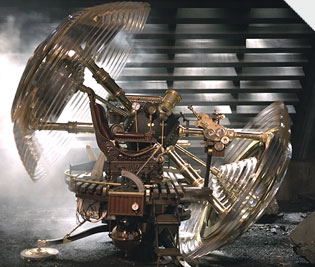

The call comes in from the control room. Stanford University’s particle accelerator-one of the largest machines on Earth-has been shut down because of a failed magnet. This is bad news for the scientists I have traveled across the continent to see: Their experiment was designed to run 24 hours a day and the disruption will cost them reams of precious data. But me, I’m thrilled. Normally, the innards of the radiation-spewing accelerator are off-limits. But idle, it poses no danger. I glance at Stew Smith, a physicist leading the experiment, and he asks if I would like to go inside. Access. I’m about to enter the heart of the cavernous, 2-mile-long accelerator. I’m about to see the place where matter meets antimatter billions of times a second.
One security checkpoint later, I don my hard hat and radiation badge and step into a building whose bland industrial features belie the tumult that goes on inside. In a procedure that reminds me of a nuclear missile launch sequence, Smith and I announce ourselves to a faceless voice coming from a speaker above our heads and then, using one key per person, sequentially unlock the main access door. Inside, ringed by a tangle of high-speed data lines, racks of circuitry, and multiple steel catwalks, is the giant detector, the heart of the Stanford Linear Accelerator, or SLAC, in Menlo Park, California.
My awe is nothing compared to what the 550 physicists worldwide working on the project will experience if their experiment works. Even in the world of physics, where investigators routinely tackle mind-bending problems like quantum uncertainty and black holes, the question these scientists are up against is truly extraordinary: Why does matter exist?
According to our best theories, all possibility for anything to be here should have been destroyed by antimatter some 15 billion years ago. Scientists believe that matter and its nemesis, antimatter, were created in equal amounts at the beginning of time and promptly canceled each other out. Yet that there is matter in the universe-from subatomic particles such as protons and neutrons to stars, planets, and every form of life-is absurdly self-evident. So physicists can’t escape the fact that they have constructed a theory of how the universe works-the so-called standard model-that denies their own existence. This is, to say the least, an uncomfortable situation.
“One of (cosmology’s) outstanding problems is that we don’t know why there’s ordinary matter in the universe today,” says Michael Turner, a University of Chicago cosmologist. “That’s a pretty big problem.”
The standard model is dear to physicists because it has unified our understanding of the microworld, successfully predicted new particles, and most important, has never been directly contradicted by experiment. But the standard model suffers from a major glitch-namely, the matter-antimatter conundrum-and physicists are striving to discover how, and precisely where, it’s wrong, or at least incomplete. “It’s the place where the standard model hasn’t really been tested,” concedes Helen Quinn, theorist at SLAC and vice president of the American Physical Society.
The holy grail in this quest is CP violation, a phenomenon that implies that antimatter is not matter’s perfect mirror image, as it’s generally thought to be. If the two sometimes behave differently, that nonconformity would help explain why the world around us exists. The standard model predicts some CP violation-and in a landmark finding last summer, the team at SLAC uncovered roughly that amount. But the CP violation predicted by the standard model is not nearly enough to explain the vast amounts of matter in the universe.
So physicists are searching for more CP violation in two very different ways. Experimental groups have designed giant, costly trials (a large portion of SLAC’s $184 million annual budget, as well as many more millions in grant money awarded to affiliated researchers at 72 institutions, goes toward the antimatter experiment). These researchers hope that their accelerators will ultimately reveal inconsistencies in the standard model-loopholes, if you will. Meanwhile, another sort of physicist, equipped only with a PC, some mathematical theorems, and lots of time to think, is taking a different approach. Members of this group want to extend the standard model-in effect, to change it. They are trying to create a new physics, and antimatter is their guide.
BACK TO THE BIG BANG
If matter is the everyday stuff of the universe, then one might assume that antimatter is its opposite. That’s not the case. Antimatter is almost exactly the same as matter, with just a few key properties reversed. The antiproton, for example, the antimatter equivalent of the proton, is identical to the proton except that it has a negative instead of a positive charge. Yet matter and antimatter have an incendiary relationship: When they meet, both are destroyed in a violent burst of light and energy.
To understand the problem this creates, you have to start from the beginning-the big bang. The universe was born 15 billion years ago as an infinitesimally tiny point of energy. We usually think of the universe in terms of stars and galaxies and impossibly huge regions of nothingness in between, but the young universe was a very different place. All the countless galaxies that exist today were then squeezed together into a space the size of a soccer ball. That compression made everything ferociously hot and energetic.
Because of that heat, the early universe was a simpler place. Its extreme heat enforced homogeneity, or what physicists refer to as symmetry. In the first moment after the big bang, the symmetry was perfect: Only energy filled the universe. But by the time the universe was less than one nanosecond old it was cooling, and the primordial energy began to coalesce, symmetrically, into perfectly equal amounts of matter and antimatter.
Herein lies the problem. If matter and antimatter destroy each other, and there were equal amounts of the two in the earliest moments of the universe, then everything should have been promptly annihilated, leaving behind only light. But what if immediately after the big bang, some of the antimatter spontaneously changed into matter? It’s conceivable; after all, radioactive elements in the periodic table can randomly change into other elements. If even a small fraction of the primordial antimatter morphed into matter, then there would have been an imbalance, and after all the pyrotechnics, some matter would have survived-potentially enough to cool and coalesce, eventually bunching into stars and galaxies.
FAITH IN THE MACHINE
Stew Smith, my guide inside the particle accelerator, is one of the leaders of the team at SLAC that’s searching for the subtle differences, or asymmetries, in the way matter and antimatter behave. In principle, it’s a simple process: Just make lots of matter and lots of antimatter, then compare the two. The challenge is perfecting it in practice.
Every particle has an equivalent antipartner-the proton has the antiproton, the electron has the positron, and so on-but it takes a very special kind of particle-antiparticle pair to reveal the variations that scientists are looking for.
Back in 1964, physicists experimenting with a particle known as the K meson and its antimatter equivalent, the anti-K meson, showed for the first time that antimatter can decay more rapidly than matter. (What scientists mean when they talk about a particle decaying is that it changes into something else. Most elementary particles are unstable, and within a fraction of a second after coming into existence they undergo a series of changes before finally reaching a stable form.)
Today, physicists believe a rare particle called the B meson, or B for short, is best suited to reveal the differences between matter and antimatter. Particles shed mass as they decay, with heavy particles turning into lighter ones. B mesons are especially heavy, which makes them ideal for asymmetry research. Think of it this way: Let’s say you’re planning a European vacation, starting from London and ending in Athens. If money is limited, you’ll travel directly, making few stops in between. But if your budget is vast and you must spend it all, you’ll visit a dozen countries along the way. Similarly, the B meson’s abundant mass, and need to shed it, creates a range of disintegration pathways. Scientists watch the various ways in which it decays, then compare the end results, checking and cross-checking their findings for consistency.
The standard model is the roadmap for this process, telling scientists which highways the B meson and the anti-B take on their trips through the subatomic equivalent of Europe, and how often they travel each one. The physicists are customs officials, checking to make sure the particles follow their assigned routes. Any deviation, however minute, implies that the standard model is either incomplete, incorrect, or inconsistent, and must be updated.
So B mesons are created and tracked in SLAC’s underground tunnels and at a competing laboratory in Tsukuba, Japan. The work’s recent success is, ironically, not the kind investigators were hoping for. They’re finding roughly the degree of CP violation that the standard model predicts-and that’s simply not enough, by a factor of a billion. If the standard model is correct, for every billion stars in today’s universe, there should be only one. One billion times fewer worlds capable of developing life. Our chances of evolving out of swamp juice on this planet, minuscule to begin with, would have been reduced by another factor of a billion. “One thing we know for sure is that the standard model by itself can’t give enough (of a) difference between matter and antimatter for us to have survived,” says Hitoshi Murayama, professor at the University of California, Berkeley.
I’m standing on a catwalk inside the SLAC accelerator, where scientists recreate the environment of the early universe. Smith is explaining how a typical measurement is made. “The electrons come through here,” he says, pointing to a narrow tube entering from the far side of the room. Positrons, the antimatter partners of electrons, emerge from the wall directly across, and the two meet head-on inside the monolith before me, traveling at nearly the speed of light. Sometimes the collision creates both a B and an anti-B, and the detector takes what is effectively a snapshot of the collision’s aftermath. As particles burst from the center of the detector, they burn their image into its multiple concentric shells. The innermost one, a device called a silicon vertex detector, is somewhat like photographic film, but made of silicon and sensitive to the slightest differences in position. The data created here is fed to vast banks of electronics, then crunched in computers around the world in a months-long analysis.
What Smith and others hope for, in their heart of hearts, is inconsistency. They want to discover, say, that the B meson rests in Paris for a week, when the standard model predicts it finishes the trip in just four days. In short, they want to find the chink in the standard model’s armor.
NEUTRINOS: A STARRING ROLE
While experimental physicists splice up tiny particles and study them like tea leaves, theoretical physicists contemplate vaster notions. Some spend their days meditating supersymmetry, a theory that postulates the existence of a bevy of yet-undiscovered particles. In addition to each particle’s antimatter sibling, supersymmetry predicts another kind of twin for every known particle. Other scientists are betting that everything in the universe is made out of unimaginably tiny vibrating strings, an idea that is alternately called string or M-theory, which has the puzzling implication that we live in a 10-dimensional universe and have only noticed the familiar three.
Murayama is exploring a theory that is rapidly becoming the favored explanation for why there is matter in the universe. It’s called leptogenesis, a shorthand way of saying that fundamental particles called leptons are our ultimate beginnings, our Genesis. In this story, Adam and Eve are replaced by the common electron and the curious neutrino, a ghostlike particle that whizzes through Earth as easily as you or I walk through a breeze.
Think of leptogenesis as a playground see-saw: when one side goes up, the other must go down. On this playground, ordinary matter sits on one end of the see-saw, and neutrinos, a kind of lepton, on the other. When the universe was very young, the theory goes, perhaps less than one-billionth of a nanosecond old and roughly the size of a hot air balloon, very heavy neutrinos morphed into a shower of antineutrinos. The antineutrinos pulled the lepton side of the see-saw down; the amount of ordinary matter had no choice but to increase.
If the leptogenesis theory is correct, “which right now pretty much everyone’s betting on,” says Murayama, then ultimately you owe your existence to the neutrino, a particle so ethereal, so seemingly inconsequential that there are trillions passing through your body as you read this.
Intriguing as leptogenesis is, no one can say for sure whether it or any of the other renegade theories about matter’s origins is correct, because the means to evaluate them do not exist. Scientists are talking of building a novel and very expensive machine, a so-called neutrino factory, that would put leptogenesis to the test. For now, though, the hands-on physicists plug away, staking out testable territory and scrutinizing the minutiae of their results, while the big thinkers tinker with the foundations of it all. Theory versus experiment: that disparity, as fundamental and as complementary, perhaps, as the one between matter and antimatter, has always been at the heart of the effort to understand our world. Chances are, the matter-antimatter problem will eventually be solved through synergy: The experimenters will find an unexpected quirk in the workings of elementary particles, and the theorists will find a consistent and elegant way to explain it.









